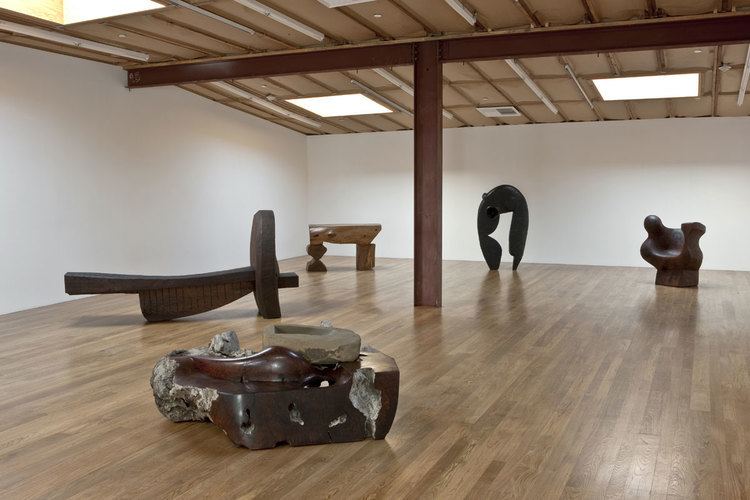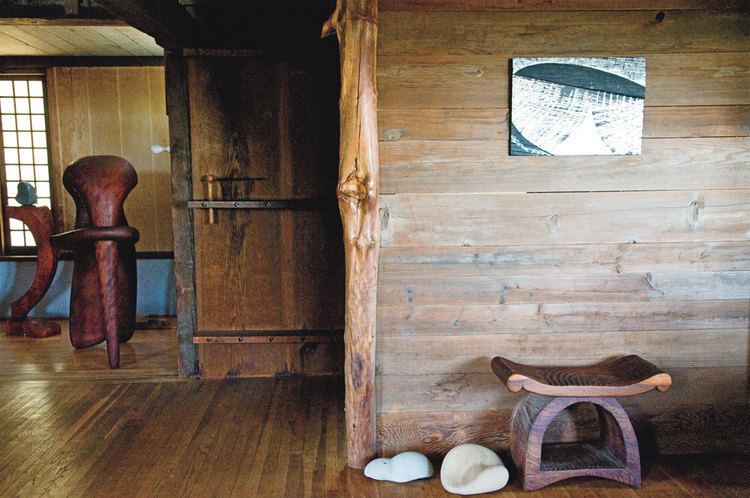Name J. Blunk | ||
 | ||
Education | ||
BIRKENSTORY #16 - Mariah Nielson, Architektin und Kuratorin von J. B. Blunk
J.B. Blunk (1926–2002) was a sculptor working primarily in wood and clay. In addition to his monumental pieces in wood and highly original work in ceramics, Blunk produced iconic works in diverse media including jewelry, furniture, painting, bronze, and stone.
Contents
- BIRKENSTORY 16 Mariah Nielson Architektin und Kuratorin von J B Blunk
- Background and Influences
- Work
- Legacy
- Selected Exhibits
- Selected Collections
- References

Background and Influences

J.B. (James Blain) Blunk was born in Ottawa, Kansas. He graduated from the University of California, Los Angeles, where he studied physics, later changing his major and studying under noted ceramist Laura Andreson. After serving in the United States Army in Korea, he met sculptor Isamu Noguchi in Japan and served apprenticeships with Japanese potter Kitaoji Rosanjin (1883–1959) and Bizen potter and Living National Treasure Kaneshige Toyo (1896–1967). Blunk was the first American to apprentice into the line of descent of that country’s great unglazed stoneware ceramic tradition.

After returning to the U.S., Blunk was eventually able to build his own home and studio near the Marin County town of Inverness, California, where he had a lifelong friendship and association with painter Gordon Onslow Ford.
Work

Among Blunk’s best-known and highly regarded public works is “The Planet” (1969), located in the lobby of the Oakland Museum of California. Writer Monica Quock Chan, in an article on the Oakland Museum, described “Planet” as follows: “In the entrance lobby sits a circular, benchlike sculpture 13 feet in diameter. Back in 1969, woodworker J.B. Blunk carved "The Planet" out of a single redwood burl, and it has been an icon of the museum for years.” Blunk created the sculpture from a two-ton piece of redwood with the help of then-apprentice Bruce Mitchell.
Glenn Adamson, writing in Woodwork magazine (October 1999), described “The Planet” as “an irregular, wildly textured circle, riddled with textural incident. The piece is unified by a rhythm of alternating jagged forms and restful, smooth shapes. The work has been called ‘one of the most touched pieces of sculpture you could find,’ and indeed it still serves as a play space, bench and oversized toy for visitors to the museum." Artist Garry Knox Bennett has said, “It’s a masterpiece. It’s an absolute masterpiece. Not only does it look good, when you see kids climbing on that and under it, you know it’s eminently successful.”
Two other monumental works are “Magic Boat,” at the California Orientation Center for the Blind, and “Greens,” at Greens, the restaurant operated by the San Francisco Zen Center at the Fort Mason Center in the Marina District of the city. In his Woodwork article, Glenn Adamson described “Magic Boat” as a “cradle-like nine-foot square sitting area with a rhythmic series of round projections that beckon to the hand.” Adamson characterized “Greens” as “a feat of engineering as well as a tour de force of woodcarving," a complex installation consisting in part of a “vertical redwood monolith” and “an assortment of small, rounded tables and stools.” The entire work was cut “from a single 22-foot diameter stump of redwood.” Like Blunk’s “other major installations,” Adamson said, “’Magic Boat’ and ‘Greens’ encourage a feeling of community through their circular compositions and inviting shapes.”
In 1988, Blunk collaborated with landscape architects Ron Wigginton and Rachada Chantaviriyavit on “Wheat Walk,” a project for the University of California, Davis, Arboretum. “Wheat Walk” was awarded first prize in an International Design Arts Competition. "Wheat Walk" has yet to be constructed.
Blunk’s work continues to be exhibited in galleries such as the Reform Gallery of Los Angeles, the 8 Gallery of San Francisco, and 101/Exhibition of Miami. His work is also offered at auction by firms such as Sotheby’s.
Sculptor Isamu Noguchi characterized the contributions of J.B. Blunk as follows:
“I like to think that the courage and independence J.B. has shown is typically California, or at least Western, with a continent between to be free from categories that are called art. Here the links seem to me more to the open sky and spaces, and the far reaches of time from where come the burled stumps of those great trees.
“J.B. does them honor in carving them as he does, finding true art in the working, allowing their ponderous bulk, waking them from their long sleep to become part of our own life and times, sharing with us the afterglow of a land that was once here.”
Legacy
From 2008 to 2012, the Lucid Art Foundation in collaboration with J.B. Blunk’s family, created an artist Residency at the home and studio of the late J. B. Blunk in Inverness, California. The four-year Residency program served 18 national and international artists. Information on the Residency program may be found at the Lucid Art Foundation website www.lucidart.org.
Biographical information along with lists of collections and exhibits plus photographs of J.B. Blunk’s work—and himself at work—may be found at the official J.B. Blunk website listed below.
